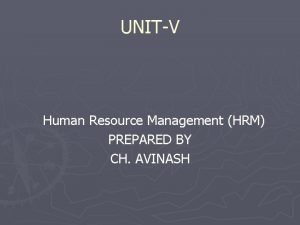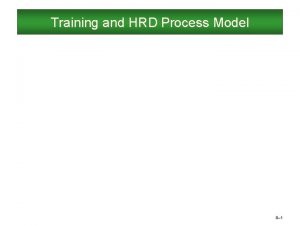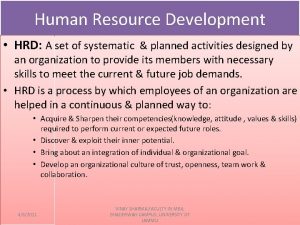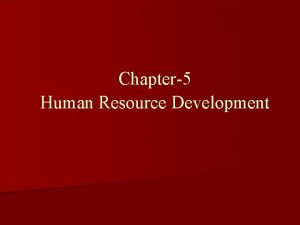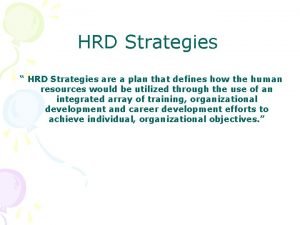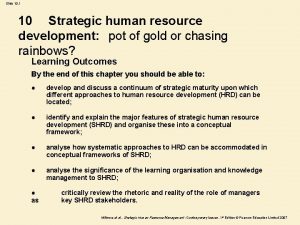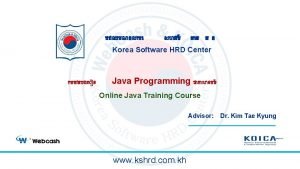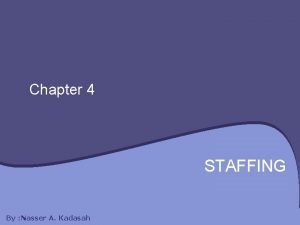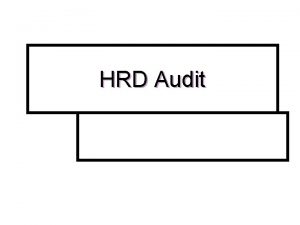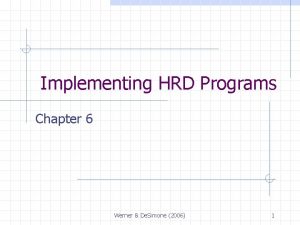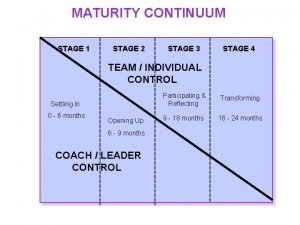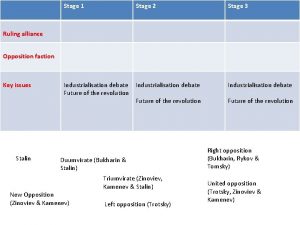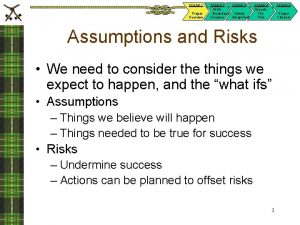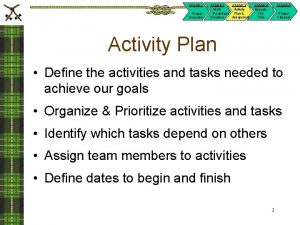Implementing HRD Programs The Implementation Stage The Learning









































- Slides: 41

Implementing HRD Programs

The Implementation Stage

The Learning Pyramid By Permission: Yin (2004)

Training Delivery Methods Three basic categories: Ø On-the-Job Training Ø Classroom Training Ø Self-Paced Training Note: Computer-based training can be in a classroom, or individual/self-paced.

On-the-Job Training (OJT) Ø Job instruction training (JIT) Ø Job rotation Ø Coaching Ø Mentoring

Characteristics of OJT Ø Training at one’s regular workstation Ø Most common form of training Ø Strengths: l l Realism Applicability Ø Weaknesses: l l No formal structure Can perpetuate mistakes

More on OJT Ø Facilitates training transfer to the job Ø Reduced training costs, since classroom is not needed Ø Noise and production needs may reduce training effectiveness Ø Quality and safety may be impacted

Job Instruction Training (JIT) Ø Prepare the worker Ø Present the task Ø Practice the task Ø Follow-up

JIT Process Ø Observe work processes Ø Brainstorm improvements Ø Analyze options Ø Implement improvements Ø Evaluate results and make adjustments

Job Rotation Ø Train on different tasks/positions Ø Often used to train entry-level managers Ø Also used to provide back-up in production positions

Coaching and Mentoring Ø Coaching – between worker and supervisor l Can provide specific performance improvement and correction Ø Mentoring – senior employee paired with a junior employee (“protégé”) l l Helps to learn the ropes Prepares protégé for future advancement

Classroom Training Approaches Five basic types: Ø Lecture Ø Discussion Ø Audiovisual Media Ø Experimental Methods Ø Self-Paced or Computer-Based Training

Lecture Ø Oral presentation of material l Some visual aids can be added Ø Remains a very popular training method l Transfers lots of information quickly Ø Interesting lectures can work well Ø Good to supplement with other materials

Problems with Lecture Method Ø One-way form of communication Ø Trainees must be motivated to listen Ø Often lacks idea sharing Ø People don’t always like listening to lectures

Discussion Method Ø Two-way communication Ø Use questions to control lesson Ø Direct: produce narrow responses Ø Reflective: mirror what was said Ø Open-Ended: challenge learners – to increase understanding

Challenges of Using the Discussion Method Ø Maintaining control in larger classes Ø Needs a skilled facilitator Ø Needs more time than lecture Ø Trainees must prepare for the lesson by reading assignments, etc.

Audiovisual Media Ø Brings visual senses (seeing) into play, along with audio senses (hearing) Ø Types: l Static Media l Dynamic Media l Telecommunications

Static Media Ø Printed materials l l l Lecture notes Work aids Handouts Ø Slides – e. g. , Power. Point Ø Overhead transparencies

Dynamic Media Ø Audio cassettes Ø CDs Ø Film Ø Videotape Ø Video disc

Telecommunications Ø Instructional TV Ø Teleconferencing Ø Videoconferencing

Experiential Training Ø Case studies Ø Business game simulations Ø Role Playing Ø Behavior Modeling Ø Outdoor training

Case Study Considerations Ø Specific instructional objectives Ø Case approach objectives Ø Attributes of particular case Ø Learner characteristics Ø Instructional timing Ø Training environment Ø Facilitator’s characteristics

Business Game Simulations Ø Computerized versus manual l Operational Financial Resource bound Ø In-basket exercise l l Setting priorities Time-driven decision making

Role Plays Ø Self discovery; use of interpersonal skills a plus Ø Some trainees are better actors Ø Transfer to job can be difficult

Behavior Modeling Ø Used mainly for interpersonal skills training Ø Practice target behavior Ø Get immediate feedback (video, among other media)

Outdoor Education Ø Ropes courses, etc. Ø Can facilitate teamwork Ø Focus on group problem identification, problem solving Ø Often good for team building Ø Fun – but is it effective training?

Self-Paced Training Ø Hard-copy l Correspondence courses l Programmed instruction Ø Computer-Based Training (CBT) l Computer-aided instruction l Internet/intranet training

Hard-Copy Self-Paced (i. e. , Self. Paced Computer-Based Training) Good for remote locations without Internet access Ø Individual follows text at own pace Ø Correct/incorrect answers determine progress Ø Trainee works alone without instructor interface Ø Still used, but increasingly being replaced by CBT Ø

Computer-Based Training (CBT) Interactive with user Ø Training when and where user wants it Ø Trainee has greater control over progress Ø CBT can provide progress reports and be tailored to specific instructional objectives Ø Trainee works on own with minimal facilitation by instructor who is elsewhere Ø

Types of CBT Ø Computer-Aided Instruction Ø Internet & Intranet-Based Training (e- learning) Ø Intelligent Computer-Assisted Instruction

Computer-Based Training (Classroom-Based) Ø Group-based Ø Instructor is present and facilitates computer-based learning Ø Trainees are collocated and can help each other Ø Requires computer, etc. , for each trainee

Computer-Aided Instruction (CAI) Ø Drill-and-practice approach Ø Read-only presentation of a “classic” training program Ø Multimedia courses Ø Interactive multimedia training Ø Simulations

Advantages of CAI Ø Interactive with each student Ø Student is self-paced Ø Logistics – l l Increasingly available over the Internet (or via an organization’s intranet) Updates are easily distributed Ø Instructional Management & Reporting Ø CAN be cost-effective…

E-learning Ø Intranet l Internal to site/organization Ø Internet l l l General communications Online reference Needs assessment, administration, testing Distribution of CBT Delivery of multimedia

Intelligent CAI Ø Uses computer’s capabilities to provide tailored instruction Ø Can use expert systems, fuzzy logic, and other rubrics Ø Can provide real-time simulation and stimulation

Implementing Training Ø Depends on: Objectives l Resources l Trainee characteristics l

Other Considerations Concerning Implementation Ø Physical environment: l Seating l Comfort level l Physical distractions

P 7 Ø Proper Ø Prior Ø Planning Ø Precludes Ø Particularly Ø Poor Ø Performance

Planning Ø Does NOT prevent failure… Ø … But makes it easier to avoid failure. Ø Planning your HRD implementation before you actually do it greatly increases the likelihood of successful implementation.

Training Provides Many Things Ø Networking Ø Knowledge Ø Social acceptance Ø Improved interpersonal skills Ø Team building

Summary Ø Good training: l l Improves performance Improves productivity Improves chances for promotion Improves the bottom line Ø Therefore, the right training methods need to be used in the right way to ensure successful HRD implementation.
 Implementing hrd programs pdf
Implementing hrd programs pdf Designing and developing effective hrd programs
Designing and developing effective hrd programs Hrd design
Hrd design Designing and implementing brand strategies
Designing and implementing brand strategies Designing and implementing brand marketing programs
Designing and implementing brand marketing programs Cpmcd full form
Cpmcd full form Cuadro comparativo de e-learning b-learning y m-learning
Cuadro comparativo de e-learning b-learning y m-learning Accessible learning experience design and implementation
Accessible learning experience design and implementation E learning implementation strategy
E learning implementation strategy Project appraisal meaning
Project appraisal meaning Hrd process model
Hrd process model Hrdsa
Hrdsa Task analysis in hrd
Task analysis in hrd Hrm vs hrd
Hrm vs hrd Hrm vs hrd
Hrm vs hrd Hrd mechanism
Hrd mechanism Hrd subsystems
Hrd subsystems Dilip ratha
Dilip ratha Scope of hrd
Scope of hrd Hrd manager
Hrd manager Hrd in government sector
Hrd in government sector What is hrd evaluation
What is hrd evaluation Functions of hrd
Functions of hrd Hrd professional
Hrd professional Hrd practices in nepalese organization
Hrd practices in nepalese organization Hrd delivery
Hrd delivery Conceptual framework of human resource development
Conceptual framework of human resource development Hrd process
Hrd process Hrd strategy
Hrd strategy Strategically-oriented cycle of hrd activities
Strategically-oriented cycle of hrd activities Hrd meaning police
Hrd meaning police Hrd score ovarian cancer
Hrd score ovarian cancer Hrd theory
Hrd theory Difference between domestic and international hrm
Difference between domestic and international hrm Hrd network
Hrd network [email protected]
[email protected] Definition of staffing
Definition of staffing Hrd subsystems
Hrd subsystems Assessing hrd needs
Assessing hrd needs Stage 1 denial
Stage 1 denial Position control definition
Position control definition What is flexible staging
What is flexible staging









